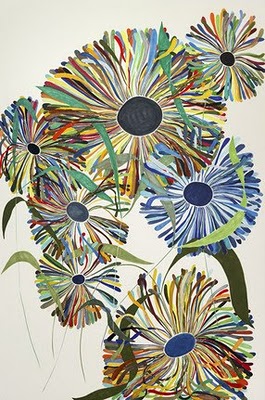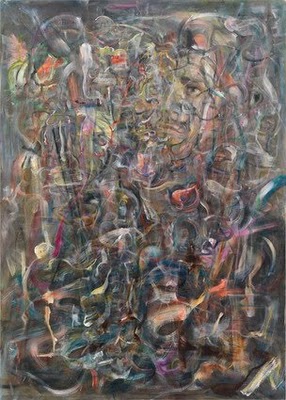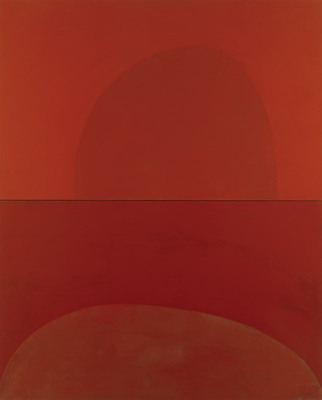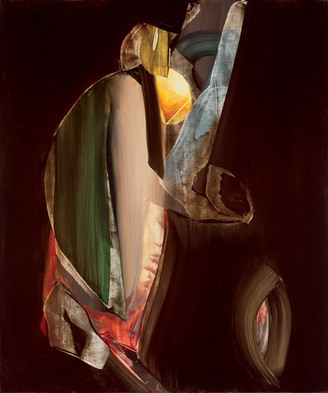I haven’t gotten into the city yet to see the Whitney Biennial and may have to skip it this time. Much time being spent painting my own work and getting house repairs finalized.
What I have seen are interesting takes on the art involved, so I’ll include a few excerpts here. I think my favorite is Sharon Butler’s review from her Two Coats of Paint blog, and you can read her full post there. She includes quite a few paintings and gives us a representative overview of the show. I haven’t included all 18 paintings, you’ll need to visit her blog to see them:
In their opening remarks on Tuesday, the 2010 Whitney Biennial curators Francesco Bonami and Gary Carrion-Murayari confessed that they approached the selection process (gasp) open-mindedly, without a preconceived theme. Fortunately, the exhibition itself faithfully reflects their intent, presenting a resonant sampling of contemporary art practice. That is not to say that the show selection is thematically unfocused or ungrounded. To the contrary, much of the work manifests a rediscovered attention to physicality in various ways: in its preoccupation with human vulnerability, in its juxtaposition of figuration and geometry, or simply in its palpable materiality.Â
Unlike the last Biennial, which offered very few canvases, 2010 features paintings around every corner. In line with the broader theme of physicality, the inclusion of so much painting signals the importance of sustained physical engagement and a renewed interest in the lifespan of the art object. Here are images from the eighteen painters (and artists who use related media) included in 2010–an impressive, thoughtfully curated exhibition.
Note: Excerpts about each artist are pulled from the Whitney’s press materials and link to the full text.Â
“Scott Short considers the concepts of authorship and reproduction. He begins by photocopying a blank piece of colored construction paper onto a blank piece of standard copy paper—a method that results in seemingly random black-and-white patterns printed on the copy paper. He then copies that copy, repeating the process multiple times and continuing the random patterning process. Once the artist selects a final permutation, the abstract image is then photographed, formatted as a slide, and projected onto a primed canvas. In the final stage, Short painstakingly recreates this image, taking care to remain true to the particular patterns and shapes generated by the machine.”
Charles Ray presents a room filled with flower paintings on paper.
“Jim Lutes integrates representation and abstraction through his use of images and lyrical marks in the same pictorial space.”
“Suzan Frecon plans her images carefully, first deciding on the dimensions of the work and the paint colors to be used (often grinding her own pigments to achieve the desired effect). She then figures out the precise imagery in sketches, using geometric formulas as well as her own visual intuition to create related forms in which dissonant features are suspended in balance.”
“Maureen Gallace finds inspiration in the modest edifices and rural environs of her native New England. She paints intimate landscapes featuring serene, unpeopled houses. Deceptively effortless in their appearance, Gallace’s paintings take shape through careful observation and decisive omission.”
“Inspired by the seventeenth-century Spanish still-life tradition, Lesley Vance carefully arranges and lights objects such as fruits or shells. The artist then photographs these arrangements, and the resulting images serve as the basis for her abstract paintings.”
Linda Yablonsky’s review in the New York Times, Women’s Fashion magazine offers a focus on women;
Hardly a Tweet had been sent after the Whitney Museum of American Art released the names of the 55 artists selected for its 75th biennial before it was already known as “the women’s biennial.†“That’s crazy,†says Francesco Bonami, the chief curator of the exhibition, now on view through the end of May. “To be the women’s biennial, 55 of the artists would have to be female.â€
Nonetheless, more than half the artists represented are women, a record for the Whitney’s marquee exhibition. Bonami and Gary Carrion-Murayari, his associate curator, say the number was happenstance. They intend their survey, titled simply “2010,†only to reflect the tenor of American art right now, which they see as “somber and intimate.†Not feminine.
If anything, “2010†suggests that the art of the moment has achieved gender equality, even if the market for it has not. But inequality is not the issue here. Whereas the wisecracking feminist protest group the Guerrilla Girls once listed “working without the pressures of success†and “having the opportunity to choose between career and motherhood†among the perks for women artists, most of those in the biennial seem blasé about their place in the social order and entitled to the occasional appearance in a fashion spread, where the glamour quotient is highest.
That would have been anathema in the 1970s and ’80s, when a gale force of feminism roared through every corridor of our culture and women made their own bodies a medium for art. In fact, many women selected for “2010†are simply making art and don’t believe their status as women has anything to do with how far they get with it — or not.
They seem preoccupied with the basics: material, color and form. (An animated exchange between some of those present for the photograph seen here moved smoothly from studio practice to lipstick.) Few would make a work today like the one Barbara Kruger did in 1989, when she stated flat out, “Your body is a battleground.â€
Holland Cotter in his Feb. 25th New York Times  article, suggests that the Biennal is referencing the economic downturn;Â
Spectacle is out. Much of what’s in is quiet and hermetic to the point of initially looking blank. The prevailing aesthetic is the art of the tweak, minute variations on conventional forms and historical styles: abstract paintings stitched like quilts, performance pieces channeling the 1960s, and so on.
In the end it was video along with photography (there’s a wonderful, half-hidden Babette Mangolte installation) that made the show tick for me, particularly standout contributions by Sharon Hayes and Kerry Tribe.
And finally, Hrag’s Hyperallergic blog offers the people’s -or the bloggers’-speak on a Whitney press preview. Really nothing to do with the exhibit itself, but with Gallery 303’s policy on photography (none):
A group of unidentified New York art bloggers were spotted at the 2010 Whitney Biennial press preview staging an absurd protest of a painting that was lent to the show by New York’s 303 Gallery. The work, Maureen Gallace, “August†(2009), was the unfortunate recipient of the bloggers’ wrath but the protesters told me that their action was not directed towards Gallace but her gallery, 303, which continues to maintain a strict anti-photography policy that is despised by many art bloggers.
Located in Manhattan’s Chelsea district, 303 represents a long list of artist who are —  perhaps inadvertently —  contributing to the gallery’s anti-photo policy through their silence. The artists include Doug Aitken, Laylah Ali, Rodney Graham, Mary Heilmann, Florian Maier-Aichen and others.
One of the art bloggers was overheard murmuring the words, “looks better blurry,†while another said, “that will teach them,†though what the lesson was wasn’t clear.
During the seemingly spontaneous event, the group took really bad photos of the art work, sometimes with their cellphones, and told anyone who would listen about 303’s photo prohibition.Â
The hooligan bloggers remain at large and assured me that they will continue to stage future actions against 303 until the gallery removes its ridiculous anti-photography policy….
“303 should know that we’re their worst nightmare,†one of them howled before disappearing into a crowd of reporters.







great overview – glad to see an increase of painters!